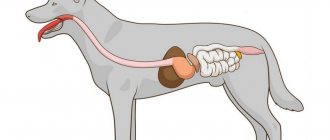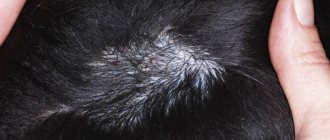Why do dogs' ears get swollen?
Many people get pets and subsequently find reliable and loyal friends. Animals, like people, suffer from various diseases. Quite often, they are diagnosed with diseases of the digestive tract, respiratory tract and various seals. Of course, pets need care, which includes scheduled and timely examination. Diagnostic measures make it possible to detect various seals, lumps and tumors, hematomas, which are quite dangerous. They typically form on the face, ears, paws and nose. This article will be useful to those who have a devoted friend in the form of a dog.
Animal disease with human character
Many people are concerned about the question: why does a dog’s ear become swollen? Four-legged friends very often encounter ear problems. They are represented by diseases of the outer, inner and middle ear.
Dog ears represent a kind of Achilles heel of the animal. However, it is not typical for all breeds. The following breeds suffer from ear pathologies:
- Dachshunds.
- Afghan hounds.
- Basset hounds.
- And other representatives of long-ears.
In first place in the frequency of diagnosing diseases of the outer ear is hematoma, and in the inner ear is otitis media. In addition, there is a risk of developing a cyst. As for the reasons for the development of bumps on the ear, they are ambiguous and varied. In some cases, the disease does not pose a danger to the animal, while others require immediate treatment. In any case, the animal must be shown to a veterinarian. Only a specialist can make an accurate diagnosis, be it papilloma or otitis media, and prescribe appropriate treatment.
Water got into my ear
Often, while bathing or swimming, water gets into the dog's ears. As a rule, the animal shakes its head, freeing the ears from fluid. But sometimes this does not happen and inflammation of the middle ear occurs, which can be facilitated by a draft. If your dog's ears become swollen as a result, you should contact your veterinarian for advice.
The problem is relevant for dog breeds with cropped ears.
To prevent inflammation, you need to:
What is the danger?
The presence of an inflammatory process in the ears may result in the process transferring to the membrane of the brain. Other complications include hematoma of the ears, rupture of the eardrum and deafness. If a polyp or other tumors are observed in the ears, they must be removed surgically. In some cases, the polyp is located deep in the ear, which is not easy to detect even for a veterinarian. In other cases, the formation is outside. With prolonged presence, the polyp becomes malignant.
Type of tumors
In the event that a dog begins an inflammatory process, first of all, it is necessary to find out what it is.
Hematoma
A hematoma is a specific blood compaction resulting from hemorrhage under the skin of the ear. In most cases, hematoma occurs in representatives with drooping ears. The cause of hematoma formation is represented by mechanical damage to the ear. This kind of compaction occurs due to damage to blood vessels or through excess fluid. The formations have a soft texture and variable shape.
During a medical examination, a soft and hot lump is detected. The animal experiences itching, so it constantly scratches the sore ear. This action causes the wound to bleed. In case of a hematoma, it is necessary to apply a cold compress, fixing it tightly. If the compress does not give a positive trend, then the veterinarian opens the dog’s ear tumor and removes the blood. The open wound is washed with hydrogen peroxide and a bandage is applied.
The ear may become swollen due to an inflammatory process occurring in the outer part of the ear canal. In some cases, otitis media is characterized by purulent discharge. The etiology of this disease is represented by inappropriate care of the animal or infection. The causative agent of otitis is ear mites.
A mite in the ear can cause severe inflammation and cause hearing loss.
Otitis media can be caused by a polyp or tumor in the ear canal. If the disease affects the middle and inner ear, then the pet is characterized by loss of the ability to navigate in space.
A sick dog's head is tilted to one side. The animal constantly scratches its inflamed ear. When pressing on a sore spot, the dog experiences pain and tries to escape.
As for the treatment and complications of this disease, only a veterinarian can clarify. In order to prevent otitis media, experts recommend rinsing the animal’s ears with hydrogen peroxide once every 14 days. After this procedure, the ears must be wiped dry. Such manipulations can be carried out after bathing your pet.
Growths
Perhaps the tumor is a common wart or papilloma. Such formations more often occur in representatives of the smooth-haired breed. The real reason for their occurrence is unknown. However, a wart or papilloma is a consequence of a viral infection. As for the appearance of the bump, it looks like a growth with a dark tint. They do not cause pain in the dog, however, papilloma is characterized by itching. Scratching will lead to infection. Therefore, it is recommended to visit a veterinarian.
If your dog's ear is swollen due to a hematoma
A hematoma is a bruise, bleeding under the skin, or blood swelling inside a dog's ear. The risk of getting a hematoma as a result of mechanical impact (bruise, irritation in the inner part of the ear) is greater in dogs with drooping ears.
You can determine that your pet has a hematoma by the following signs:
There is a tumor outside or inside the ear that is hot to the touch.
The animal constantly shakes its head and scratches its ear.
As a result of scratching, an abrasion is formed, a wound that bleeds.
In some cases, the auricle is torn.
If there is a hematoma on the ear, apply a cold compress and make a tight bandage, which should be changed daily. In most cases, the bruise resolves. If this measure is ineffective, the tumor is opened and the clotted blood is removed. The open cavity is washed with a disinfectant solution such as potassium permanganate, hydrogen peroxide, and then bandaged so that the dog cannot scratch the wound and thereby aggravate the situation.
Why can a dog's ear swell?
Dogs' ears can be damaged for various reasons: from mechanical trauma to infection or tumor growth inside the ear canal. In each of these cases, ear swelling may be noticeable even externally when one or more sides of the thin ear cartilage become larger. In some cases, the tissues can become so swollen that the ear canal narrows and the animal begins to hear poorly. Whatever disease causes the tumor, it is better for the dog owner to take the pet to the veterinarian as soon as possible, without waiting until the tissues begin to swell even more.
The most common causes of swollen ears in dogs include:
- Hematomas. They look like bruises, with hemorrhage in the subcutaneous area. They are usually formed as a result of mechanical impact: bruise or irritation of the inside of the ear space. In addition to swelling, the main signs of a hematoma will be a new growth in the internal space that is hot to the touch, constant head shaking and scratching by the dog, the appearance of abrasions and wounds, sometimes with tearing of the auricle.
- Otitis. The most common reason for the development of otitis is poor care of the dog and failure to comply with sanitary and hygienic standards for its maintenance, although the possibility of infection entering the passage should not be ruled out. The main external manifestations of otitis include: scratching the ears, shaking the head, pain, accumulation of dirt and inflammation in the inside of the shell. If you lean towards the animal, you may notice an unpleasant, sometimes pungent odor.
- Allergy. It manifests itself in redness, swelling and the appearance of pimples or ulcers at the site of the lesion. Typically, allergic reactions are the result of a dog consuming new food mixtures, medications, or contact with household chemicals or hair care products.
- Abscess. The appearance of such a neoplasm resembles a hematoma, only its internal space is filled not with blood, but with pus. In this case, the dog's ear will swell due to tissue damage and infection by pathogens.
- A foreign object or water gets inside the ear. The pet often tries to remove them on his own, vigorously shaking his head and trying to reach the interfering object with his paw.
- Papillomas and warts. May be characteristic of any dog, especially those with large ears. Often the cause of the appearance of such neoplasms is infectious infections that can cause severe discomfort to the pet in the form of itching and irritation.
- Oncology. Benign or malignant tumors can very quickly increase in size, inflate and even change shape, closing the inner ear space. As when a foreign object hits, the pet will shake its head intensely, try to reach the interfering object with its paw, and hang its erect ears, tilting its head towards the affected area.
Why is my dog's ear swollen?
When a dog's ear is swollen , it is necessary to find out the cause of the phenomenon in order to help the animal. There are many causes of swelling, and their treatment is not the same. A pet can suffer at any age. The problem most often occurs in dogs with floppy ears.
Causes and treatment
The owner can treat the dog on his own only if the outer ear is swollen. There are several main reasons that cause this problem.
- Otitis is the most common reason why the ear swells. Due to inflammation, the mucous membranes of the ear swell, which is clearly visible. Additional symptoms of the disease are the presence of dirt in the ear canal and the discharge of pus or liquid with an extremely unpleasant odor from the ear. The swollen area is painful and the dog will not allow you to touch it. For treatment, antibiotic drops or levomekol or tetracycline ointment are used to place in the ear canal after cleaning it. In severe cases, it is necessary to administer a course of injections of strong broad-spectrum antibiotics. For otitis media of a fungal nature, the use of special antimycotic drops is indicated.
- Hematoma. In most cases, it is a consequence of an ear injury, but it can also be one of the symptoms of infectious diseases. In this condition, lymph and blood accumulate under the skin. Often there is not only swelling of the ear, but also blue discoloration. In mild cases, for treatment it is enough to apply cold compresses for several days in a row; in severe cases, the hematoma is opened surgically, after which the tissue is cleansed and the cavity is sanitized.
- Allergies are also often the reason why a dog's ear is swollen. In addition to swelling, in such a situation the dog suffers from severe itching in the ears, and often inflammation, due to which pus begins to be released. Allergies can be caused by food, parasite repellents, and insect bites. To eliminate the problem, it is necessary to give the animal suprastin (taking into account the weight) and put a special anti-allergic composition for dogs in the ears. In the future, it is important to protect your pet from contact with the allergen.
- Abscess. Suppuration develops from an insect bite and a wound in the ear if there is an infection. The ear becomes swollen due to the accumulation of pus. Treatment is carried out surgically. The abscess is opened, cleaned, and the cavity is disinfected. When the abscess is soft and located at the end of the ear, you can try to accelerate its maturation by applying a mixture of ichthyol ointment and levomekol ointment, combined in equal quantities. The result should appear in 2-3 days. After opening the abscess, a mixture of ointments is applied for another 2 days, and then until the ear heals - only levomekol.
- Papillomas and warts. The appearance of these tumors in the ear canal can cause swelling of the ear. More often, swelling appears after vaccination, or when the pet is unwell due to decreased immunity, since neoplasms are predominantly viral in nature. To restore a normal state, a dog needs a course of immunostimulants.
When a dog’s ear is swollen inside, and the process proceeds rapidly, and there is no hematoma, then there is a high probability of foreign objects getting into it. To quickly relieve swelling, instillation of olive or sunflower oil is used, which is preheated strongly for disinfection and then left to cool to room temperature.
As soon as the swelling is removed, the foreign object is removed. Most often, small pebbles, insects, leaves or small twigs are found in the ear. When removing them, it is important to be careful not to injure the tissue.
The dog's ear is swollen photo
During the warm season, the animal may suffer from stinging insect bites, which cause severe swelling. If a dog is allergic to wasp or bee venom, there is a high risk of death due to swelling of not only the stung ear, but also the pharynx, which will block the lumen and cause suffocation.
When a dog is stung in the ear, it immediately swells greatly, and upon careful examination, the owner discovers a small wound, the remaining field of the sting. If a bee stings, the sting itself will most likely remain in the skin. The dog is experiencing severe pain.
To prevent swelling of the ear from being very severe, immediately after the bite you should wipe the affected area with alcohol and then apply cold to it. To prevent the development of an allergic reaction, the animal is given suprastin. If after a bite the swelling from the ear does not subside within 24 hours, this indicates the beginning of the inflammatory process, so it is necessary to apply ichthyol ointment to the damaged area.
When a dog's ear is swollen on the outside , the most likely cause is a bite. Often there are multiple bites, then swelling occurs not only in the ear area, but throughout the entire face, which is a dangerous condition. When a pet's ear is swollen, the owner must help him without delay.
Source: https://kozhasobak.com/u-sobaki-opuhlo-uho.html
How to tell if your dog has ear problems
Any deviations in the dog’s well-being will not go unnoticed by the attentive owner. Determining if an animal has ear problems is not so difficult; you just have to observe its behavior. The following symptoms usually indicate swelling of the ear:
- tilting the head to one side, and this position is observed constantly;
- attempts to press the sore ear to the head;
- display of aggression when trying to examine the ear;
- sudden changes in behavior and mood;
- increased tension in the neck, but only on one side;
- shaking the head and trying to get something out of the ear with a paw, often tearing the skin until it bleeds;
- sleep disturbance and refusal to eat;
- whining and other sounds uncharacteristic for a dog;
- discharge of purulent exudate from the ear, with an unpleasant pungent odor.
What to do if your dog has a swollen ear
Any of the above-described deviations has its own treatment regimen, based on the use of certain medications. Whether the cause of the swelling is a hematoma or the dog suffers from otitis media, in any case, its positive outcome depends on the timeliness of the treatment started.
Hematoma
The first thing to do when you find a hematoma in your dog’s ear is to apply a cold compress and place a tight bandage on the head, which will have to be changed daily. In 3-4 days, the bruise should resolve on its own, but if this does not happen, surgical intervention will be required, which involves opening and removing the blood that has coagulated under the skin. The remaining open cavity must be disinfected with a solution of potassium permanganate or hydrogen peroxide, and then bandaged so that the dog cannot scratch the wound. Standard painkillers, for example, Analgin or No-shpa, will help relieve pain.
Allergy
To combat an allergic reaction to food, an insect bite or a drug, it is best to use antihistamines, with the obligatory exclusion of the allergen that provokes the disorder. The dosage of tablets for a pet should be calculated taking into account its age and weight, and the most famous drugs of this group today include Diazolin or Suprastin.
Otitis, or inflammation of the mucous membrane of the external auditory canal, can have a different nature, but in almost all cases it is observed with the addition of an infection. Outwardly, this manifests itself in the release of purulent exudate from the ear canal, and in some cases, examining ear discharge under a microscope, laboratory assistants notice an ear mite, which is the causative agent of the disease.
To eliminate the problem, antibiotics included in ear drops (for example, Anandin) are often prescribed. The drugs Otibiovin and Otoflox are no less effective, but in any case, before instillation, you need to clear the ear cavity of accumulated exudate and only then drip the selected product. Vegetable oils will help soften dried crusts, and to disinfect the surface of the inside of the ear, the use of chlorhexidine would be appropriate.
Abscess
It will not be possible to remove suppuration without surgery, therefore, in order not to worsen the situation, you should consult a doctor as soon as possible for qualified surgical help. When opening an abscess, it is very important not to damage the vessels close to the surface of the skin and to clean out all the pus that has accumulated in the cavity. At the end of the procedure, the remaining wound is washed with peroxide, Levomikol ointment is applied and wrapped with a bandage to prevent infection from the outside. Healing proceeds according to the usual pattern, and the owner only needs to ensure that decay does not begin. Otherwise, you will have to resort to the use of broad-spectrum antibacterial drugs: for example, the cephalosporin or penicillin group. Sometimes these drugs are prescribed immediately after removal of the abscess contents for preventive purposes.
My dog's ear is swollen, what should I do?
My dog's ear is swollen, what should I do?
Ear problems in domestic dogs often occur and it is not difficult to understand that your pet is suffering from them. Ears are one of the most important organs of a dog, and they not only react sensitively to noises and voices, but are also very susceptible to various kinds of ailments.
The dog's ear is swollen - the causes of swelling can be otitis media, ear mites, or hematoma. Be that as it may, the owner must take emergency measures to eliminate the source of inflammation in order to alleviate the suffering of the pet, and immediately take him to a specialist.
If this is not done, the consequences can be dire - hearing loss, brain complications and even death.
If your dog's ear is swollen due to a hematoma
A hematoma is a bruise, bleeding under the skin, or blood swelling inside a dog's ear. The risk of getting a hematoma as a result of mechanical impact (bruise, irritation in the inner part of the ear) is greater in dogs with drooping ears.
You can determine that your pet has a hematoma by the following signs:
- There is a tumor outside or inside the ear that is hot to the touch.
- The animal constantly shakes its head and scratches its ear.
- As a result of scratching, an abrasion is formed, a wound that bleeds.
- In some cases, the auricle is torn.
If there is a hematoma on the ear, apply a cold compress and make a tight bandage, which should be changed daily. In most cases, the bruise resolves.
If this measure is ineffective, the tumor is opened and the clotted blood is removed.
The open cavity is washed with a disinfectant solution such as potassium permanganate, hydrogen peroxide, and then bandaged so that the dog cannot scratch the wound and thereby aggravate the situation.
If your pet has otitis media
The ear may become swollen and swollen due to otitis media, which refers to inflammation of the mucous membrane of the external auditory canal. Often accompanied by the discharge of purulent, foul-smelling fluid from the sink. During a diagnostic examination (examination of a scraping from the ear under a microscope), an ear mite (Otodectes cynotis) can be detected, which is the causative agent of the disease.
The most common reason leading to otitis media is poor dog care, when it does not undergo the necessary hygienic procedure - regular ear cleaning. An infection can also contribute to the development of the disease, which can cause the ears to swell.
Symptoms of otitis media:
- The dog scratches its ear, shakes its head, tilts it to the side.
- When examining and feeling the inflamed area, the animal experiences severe discomfort, whines and breaks out.
- Dirt accumulates inside the ear.
- The skin is inflamed.
- There is an unpleasant odor coming from the ear.
There are three types of otitis: external, middle, inflammation of the middle ear. Therefore, only a doctor prescribes treatment, because the owner may make a mistake and start putting drops into the pet’s ears for another form of otitis, which differs from the real disease. As a rule, antibiotics are prescribed; the most common drug in this case is Anandin drops.
If discharge appears, the ears are washed with saline or chlorhexidine. The crusts are first softened with vegetable oil, then carefully removed and treated with hydrogen peroxide.
If a foreign body gets into the dog's ear
A foreign object can get into a dog's ear, for example, during games with children, when naughty kids stick small objects - balls, beads, peas - into the pet's ear.
They cause a lot of discomfort and, trying to get rid of the foreign body, the dog begins to shake and shake its head, trying to reach the inside of the ear.
A dog behaves in exactly the same way if an insect gets into its ear.
You can fix the problem yourself. To do this, drop a few drops (5-10) of any oil that you have on hand into your pet’s ear. The main condition is that it must first be sterilized. As a rule, after this procedure, the swelling subsides within 1-2 days. If it was not possible to get the foreign object, the owner should take the pet to a veterinarian.
If water gets into your dog's ear
During the water procedure, water often gets into the dogs' ears.
Most often, animals manage to get rid of fluid accumulated in the ear canal on their own by shaking and shaking their heads in different directions.
If the dog doesn’t succeed, the owner’s task is to help the pet get rid of the discomfort. This must be done, since if there is a draft, the dog may experience a complication in the form of inflammation of the middle ear.
What to do to remove water from your ear:
- Secure the dog's position with a blanket.
- Turn your pet on its side so that its ear is down.
- Lightly shake your head to speed up the process of water leaving the ear cavity.
- Wipe the auricle with a stick on which a strand of cotton wool is wound. The manipulation is repeated until the cotton wool becomes completely dry.
The most susceptible to water getting into the ear canals are dogs with cropped ears (their shells are completely open), such as Doberman Pinschers and Great Danes. But representatives of the Newfoundland and Labrador breed practically do not encounter this problem.
The ingress of water can be prevented if, before bathing, you place tampons lubricated with Vaseline oil in your pet’s ears, or treat them with special powder.
Source: https://www.belanta.vet/vopros-otvet/view/Ushi/sobaki-opuhlo-uho/
Why are ear tumors dangerous?
Any swelling of the ears poses a direct threat to the dog’s hearing, because even if the tumor in the ear is not malignant, the possibility of blocking the ear canal and squeezing important blood vessels cannot be ruled out. An advanced inflammatory process in the ears can have a negative effect on the dog’s brain, sometimes causing inflammation there as well (meningitis). Malignant tumors often form metastases, so even after excision of the tumor itself there is a chance of losing the animal due to cancer. To prevent this, it is important to contact a veterinarian in a timely manner, even if the reasons for prolonged ear swelling in the animal seem clear to the owner.
Prevention of ear inflammation in dogs
Thus, owners need to make every effort to prevent the development of otitis media in their pets. Comprehensive prevention of ear inflammation in dogs gives good results:
- Your dog's ears need to be cleaned at least once a week. If the dog is used as a hunting or working dog (there is a higher risk of ear contamination) or has long ears, it is better to increase the frequency of cleaning to twice a week.
- If the dog is a long-haired breed, then it is necessary to regularly trim off excess hair that blocks the ear canal and interferes with the natural ventilation of the ear.
- In addition, it would not be a bad idea to bring your pet to the veterinarian for a preventive examination once a quarter. This will help to timely identify and treat not only otitis media, but also other dangerous diseases.
Preventing ear problems in dogs
Despite the wide variety of different ear problems in dogs, to prevent any cause of swelling, you should adhere to the following simple recommendations:
- Regularly and thoroughly clean your pet's ears with a cotton swab, possibly instilling them with special antibacterial drops prescribed by your veterinarian.
- In dogs with long-haired breeds, excess hair should be trimmed regularly, especially on the inside of the ear (this is the only way to achieve normal filtration and prevent increased humidity).
- After bathing your pet, the ear canal should be blotted with a cotton swab, removing any remaining water from it.
- Make sure that the dog does not become hypothermic, and this is possible not only in the cold season, but also in the summer.
- Visit your veterinarian regularly and adhere to your pet's routine vaccination schedule.
- Treat any bacterial or viral ailments in a timely manner, especially those localized in the head area.
- Avoid contact between your pet and yard dogs, because you can never be sure that stray animals do not have infectious diseases.
- Regularly treat your dog for skin parasites, and also do everything possible to ensure that your pet does not suffer from dermatological ailments.
Swelling of the ear is a serious reason to examine the animal more carefully, if possible in a veterinary clinic. Whatever the cause of the disorder, without timely help the dog’s well-being will only worsen, not to mention possible hearing loss or brain damage. Only with a responsible approach to your pet’s health will it be possible to save its life for many years.
Source
Tatyana I.
My dog's ear is swollen, what should I do?
Ear problems in domestic dogs often occur and it is not difficult to understand that your pet is suffering from them. Ears are one of the most important organs of a dog, and they not only react sensitively to noises and voices, but are also very susceptible to various kinds of ailments. The dog's ear is swollen - the causes of swelling can be otitis media, ear mites, or hematoma. Be that as it may, the owner must take emergency measures to eliminate the source of inflammation in order to alleviate the suffering of the pet, and immediately take him to a specialist. If this is not done, the consequences can be dire - hearing loss, brain complications and even death.











